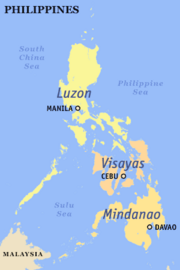Visayas
| Native name: Kabisay-an | |
 Map of the Philippines; the center shows the location of the Visayas |
|
| Geography | |
|---|---|
| Location | South East Asia |
| Archipelago | Philippines |
| Major islands | Bohol, Cebu, Leyte, Masbate, Negros, Panay, Samar |
| Area | 58,295 km |
| Highest point | Kanlaon (2,435 meters (7,989 ft)) |
| Country | |
| Regions | Central Visayas, Eastern Visayas, Western Visayas |
| Largest city | Cebu |
| Demographics | |
| Population | 17.3 million (as of 2005) |
| Density | 297 people/km2 |
| Ethnic groups | Visayans (Aklanon, Boholano/Bol-anon, Caluyanon, Capiznon, Cebuano, Eskaya, Hiligaynon, Karay-a, Masbateño, Porohanon, Romblomanon, Waray), Ati |
Visayas (Visayan: Kabisay-an) is one of the three island groups in the Philippines, along with Luzon and Mindanao. It consists of several islands, primarily surrounding the Visayan Sea. Its inhabitants are referred to as the Visayans.
The major islands are:
Culturally it may also include the following whose inhabitants identify as Visayan:
Contents |
History
Up to now the history of the Visayas before the arrival of the Spanish remains a mystery. The first known mention of the Visayas in history is in the 12th century, when the region is thought to have been ruled by the empire of Srivijaya.
Visayans were thought to have kept close diplomatic relations with the various Javanese and Malay kingdoms since the locals of Cebu were able to converse with Enrique of Malacca using Malay when Ferdinand Magellan arrived in 1521.
After Magellan's expedition, the Spanish became interested with the archipelago and sent Ruy López de Villalobos and Miguel López de Legazpi in 1543 and 1565, respectively, to explore and colonize the islands.
At first, the Visayans accepted this colonization and many began converting to Christianity and started to accept the Santo Niño as their patron. However, the situation soon turned sour and revolutions such as those of Francisco Dagohoy began to emerge.
The Spanish weren't the only problems of the Visayans. Moros are thought to have invaded various Visayan islands during this era.
During the Philippine Revolution, Visayans were active participants. The island of Negros itself initiated their own revolution.
After Philippine independence, Visayans continued to participate in Philippine politics with the presidents coming from the Visayas.
On May 23, 2005, Palawan was transferred to Region VI (Western Visayas) by Executive Order 429.[1] The Department of the Interior and Local Government announced in June 2005 that the transfer had been completed.[2] However, Palaweños criticized the move, citing a lack of consultation, with most residents in Puerto Princesa City and all municipalities but one preferring to stay with Region IV-B. Consequently, Administrative Order No. 129 was issued on August 19, 2005 to address this backlash. This Order directed the abeyance of Executive Order 429 pending the approval of an implementation plan for the orderly transfer of Palawan from Region IV-B to Region VI.[3] Hence, Palawan is currently (as of May 2007) still part of Region IV-B.
Administrative divisions
Administratively, Visayas is divided into 3 regions, namely Western Visayas, Central Visayas and Eastern Visayas. Each region is headed by a Regional Director which is elected from a pool of governors from the different provinces in each region.
However, it is made up of 16 provinces. The Visayas comprises 16 provinces, each headed by a Governor. A governor is elected by popular vote and can serve at the maximum of three terms of three years each.
As for representation in the Philippine Congress, the Visayas is represented by 44 Congressmen elected the same way as the Governors.
Western Visayas (Region VI)
Western Visayas consists of the islands of Panay and the western half of Negros. The regional center is Iloilo City. Its provinces are:
Central Visayas (Region VII)
Central Visayas includes the islands of Cebu and Bohol, and the eastern half of Negros. The regional center is Cebu City. Its provinces are:
Eastern Visayas (Region VIII)
Eastern Visayas consists of the islands of Leyte and Samar. The regional center is Tacloban City. Its provinces are:
- Biliran
- Leyte
- Southern Leyte
- Eastern Samar
- Northern Samar
- Samar
Culture
Legends
There are legends, which are compiled in the book Maragtas, which tell the story of ten chiefs (Datus) who escaped from the tyranny of Datu Makatunaw from Borneo to the islands of Panay. The chiefs and followers are believed to be the ancestors of the Visayan people. The arrival is celebrated in the Festivals of the Ati-Atihan in Kalibo, Aklan and Binirayan in San Jose, Antique. While these are stories, they are believed by some to be based on actual facts and events which were compiled into a 1907 book by Pedro Alcantara Monteclaro. This belief has been debunked, however, by Philippine historian William Scott.[4]
Panay also boasts as its oldest and longest epic, the Hinilawod.
Hypotheses
A contemporary theory based on a study of genetic markers in present-day populations that Austronesian migrants from Taiwan populated Luzon and headed south to the Visayas, Borneo, modern day Indonesia, then to the Pacific islands to the east.[5] The study, though, may not explain interisland migrations, which are also possible, such as the Tagalog migration to Luzon.
See also
Notes
- ↑ President of the Philippines. "Executive order No. 429". Office of the Press Secretary. Retrieved on 2007-05-18.
- ↑ Government of the Philippines - News (3 June 2005). "Palawan, Puerto Princesa Transfer to Region VI". Press release. Retrieved on 2007-05-18.
- ↑ President of the Philippines (August 19, 2005). "Administrative Order No. 129". Office of the Press Secretary.
- ↑ Scott 1984, pp. 81-103.
- ↑ Cristian Capelli et al. (2001). "A Predominantly Indigenous Paternal Heritage for the Austronesian-Speaking Peoples of Insular Southeast Asia and Oceania". American Journal of Human Genetics 68: 432–443. doi:. http://hpgl.stanford.edu/publications/AJHG_2001_v68_p432.pdf.
References
- Scott, William Henry (1984), Prehispanic Source Materials for the study of Philippine History, New Day Publishers, ISBN 971-10-0226-4.